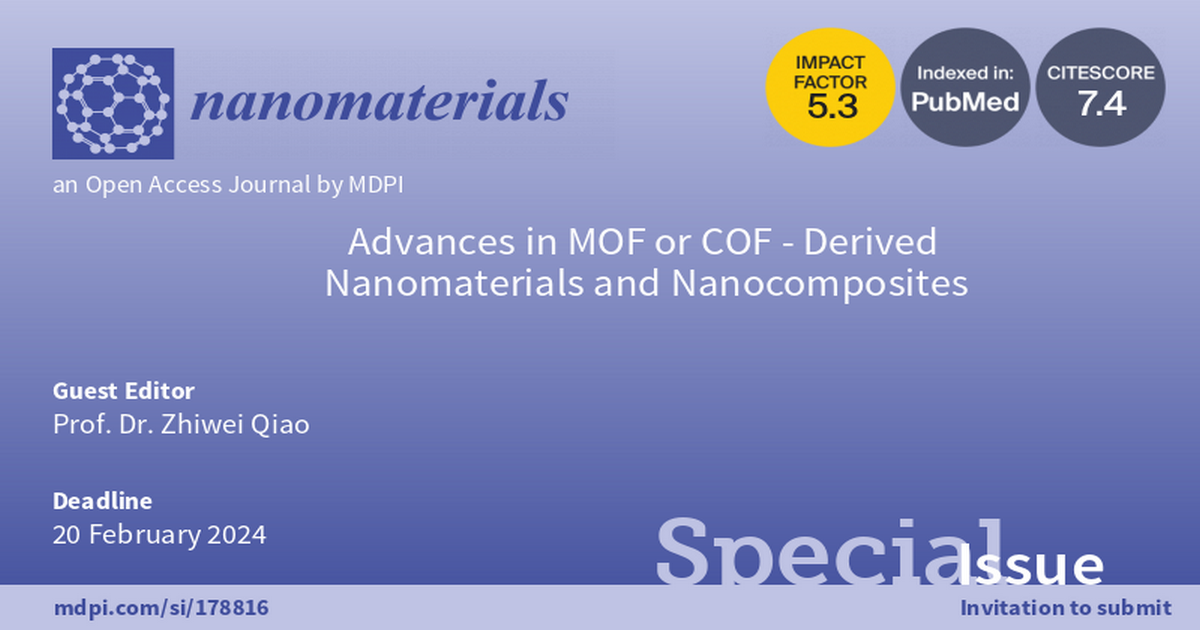Advances in MOF or COF-Derived Nanomaterials and Nanocomposites
A special issue of Nanomaterials (ISSN 2079-4991). This special issue belongs to the section "Inorganic Materials and Metal-Organic Frameworks".
Deadline for manuscript submissions: closed (20 February 2024) | Viewed by 6111

Special Issue Editor
Interests: metal‒organic frameworks; gas separation; molecular simulation; machine learning
Special Issues, Collections and Topics in MDPI journals
Special Issue Information
Dear Colleagues,
Organic‒inorganic hybrid materials with interpenetrating porosity, tunable chemical structures, and excellent performance have attracted tremendous attention. Recently, there has been increasing interest in delivering advanced organic‒inorganic hybrid materials for energy utilization and environmental remediation. It will focus on various organic‒inorganic hybrid materials including metal‒organic frameworks (MOFs), zeolitic‒imidazolate frameworks (ZIFs), mixed-matrix polymeric material, porous metal/metal oxide/graphene hybrid materials, and so on.
The conventional techniques of separation, such as the desalination of sea water, are highly energy-intensive. As an alternative, material separation is technically feasible and economically viable with the advantages of easy operation, low cost, and high efficiency. In these techniques, it is critically important to design and develop novel high-performance separation materials. Despite organic‒inorganic hybrid materials being up-and-coming candidates in separation applications, more synthesis strategies and microscopic mechanisms are required to investigate the promising organic‒inorganic hybrid materials with high efficiency and low cost for the energy and environmental fields.
This Special Issue will provide a comprehensive overview on recent advances in designing and advancing organic‒inorganic hybrid materials for gas separation, catalysis, thermal energy storage, etc. The selected articles will provide a state-of-the-art overview of the progress over the last years in the design, synthesis, characterization, simulation, and application of organic‒inorganic hybrid materials.
Potential topics include but are not limited to the following:
- Development and characterization of new organic‒inorganic hybrid materials;
- Calculation and simulation of the structure‒property relationships of organic‒inorganic hybrid materials;
- Incorporation of different inorganic substances in the polymeric matrix, such as metal/metal oxide/sulfide/phosphide, graphene, etc.;
- Studying the potential applications of organic‒inorganic hybrid materials;
- Separation and purification of gases or liquids;
- Storage of gases (H2, CO2, CH4, etc.);
- Desalination of sea water;
- Thermal energy storage;
- Lithium battery material.
Prof. Dr. Zhiwei Qiao
Guest Editor
Manuscript Submission Information
Manuscripts should be submitted online at www.mdpi.com by registering and logging in to this website. Once you are registered, click here to go to the submission form. Manuscripts can be submitted until the deadline. All submissions that pass pre-check are peer-reviewed. Accepted papers will be published continuously in the journal (as soon as accepted) and will be listed together on the special issue website. Research articles, review articles as well as short communications are invited. For planned papers, a title and short abstract (about 250 words) can be sent to the Editorial Office for assessment.
Submitted manuscripts should not have been published previously, nor be under consideration for publication elsewhere (except conference proceedings papers). All manuscripts are thoroughly refereed through a single-blind peer-review process. A guide for authors and other relevant information for submission of manuscripts is available on the Instructions for Authors page. Nanomaterials is an international peer-reviewed open access semimonthly journal published by MDPI.
Please visit the Instructions for Authors page before submitting a manuscript. The Article Processing Charge (APC) for publication in this open access journal is 2400 CHF (Swiss Francs). Submitted papers should be well formatted and use good English. Authors may use MDPI's English editing service prior to publication or during author revisions.
Keywords
- organic‒inorganic hybrid materials
- metal‒organic frameworks
- mixed-matrix polymer
- separation of gases or liquids
- simulation of materials
Benefits of Publishing in a Special Issue
- Ease of navigation: Grouping papers by topic helps scholars navigate broad scope journals more efficiently.
- Greater discoverability: Special Issues support the reach and impact of scientific research. Articles in Special Issues are more discoverable and cited more frequently.
- Expansion of research network: Special Issues facilitate connections among authors, fostering scientific collaborations.
- External promotion: Articles in Special Issues are often promoted through the journal's social media, increasing their visibility.
- Reprint: MDPI Books provides the opportunity to republish successful Special Issues in book format, both online and in print.
Further information on MDPI's Special Issue policies can be found here.






